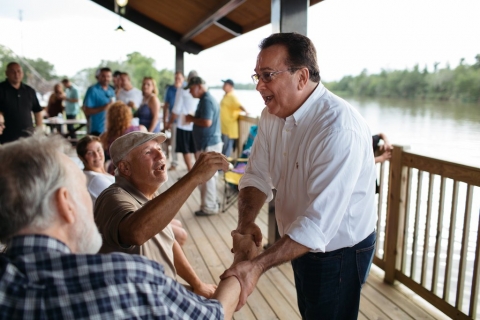
JEAN LAFITTE, LA. — From a Cessna flying 4,000 feet above Louisiana’s coast, what strikes you first is how much is already lost. Northward from the Gulf, slivers of barrier island give way to the open water of Barataria Bay as it billows toward an inevitable merger with Little Lake, its name now a lie. Ever-widening bayous course through what were once dense wetlands, and a cross-stitch of oil field canals stamp the marsh like Chinese characters.
Saltwater intrusion, the result of subsidence, sea-level rise and erosion, has killed off the live oaks and bald cypress. Stands of roseau cane and native grasses have been reduced to brown pulp by feral hogs, orange-fanged nutria and a voracious aphid-like invader from Asia. A relentless succession of hurricanes and tropical storms — three last season alone — has accelerated the decay. In all, more than 2,000 square miles, an expanse larger than the state of Delaware, have disappeared since 1932.
Out toward the horizon, a fishing village appears on a fingerling of land, tenuously gripping the banks of a bending bayou. It sits defenseless, all but surrounded by encroaching basins of water. Just two miles north is the jagged tip of a fortresslike levee, a primary line of defense for greater New Orleans, whose skyline looms in the distance. Everything south of that 14-foot wall of demarcation, including the gritty little town of Jean Lafitte, has effectively been left to the tides.
Jean Lafitte may be just a pinprick on the map, but it is also a harbinger of an uncertain future. As climate change contributes to rising sea levels, threatening to submerge land from Miami to Bangladesh, the question for Lafitte, as for many coastal areas across the globe, is less whether it will succumb than when — and to what degree scarce public resources should be invested in artificially extending its life.
One sweltering evening last July, almost everyone from around Lafitte gathered near dusk at the bayou’s edge to celebrate the expenditure of nearly $4 million of those scarce public resources. There were shrimpers and crabbers, tug captains and roughnecks, teachers and cops. All had come for the ribbon cutting for a grand new seafood pavilion, the latest gambit by the longtime mayor, Timothy P. Kerner, to save the town from drowning.
Free beer sloshed in plastic cups as folks ambled about the cavernous, open-sided shed, sampling shrimp rémoulade and alligator-stuffed mushrooms. Once the politicians had finished flattering one another from the podium, a Cajun band, fronted by a fiddler in a shimmery blue dress, cranked up a rollicking fais-dodo.
Amid the celebration, a fireplug of a man in crisp jeans and a starched white shirt cheek-kissed and bro-hugged his way through the crowd. This was Timmy Kerner’s party. In his third decade as mayor, Mr. Kerner had managed to persuade the parish, state and federal governments to pay for his signature showcase at the entry to town.
It might seem counterintuitive to keep building on land that is submerging. But Mr. Kerner did not see it as his job to take a 10,000-foot view. In the years since Hurricane Katrina, he had grown weary of being rebuffed in his quixotic campaign to encircle Lafitte with a tall and impregnable levee. He could rhapsodize all he wanted about preserving his community’s authentic way of life. The cost-benefit calculus — more than $1 billion to protect fewer than 7,000 people — always weighed against him.
So he had set out to change it. His strategy was to secure so much public investment for Jean Lafitte that it would eventually become too valuable to abandon. In a decade, he had built a 1,300-seat auditorium, a library, a wetlands museum, a civic center and a baseball park. Jean Lafitte did not have a stop light, but it had a senior center, a medical clinic, an art gallery, a boxing club, a nature trail and a visitor center where animatronic puppets acted out the story of its privateer namesake.

